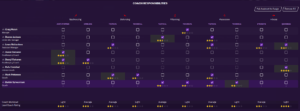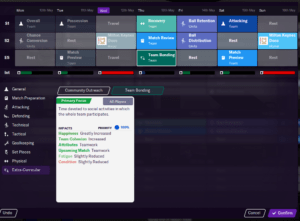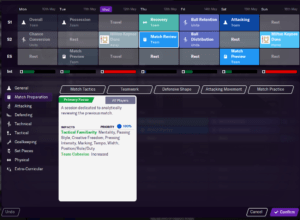
FM21 Training Features – Give Your Team the Edge!
When managing your team, they say the hard work begins with the basics in training. In Football Manager, this is no exception. It’s not always about picking a tactic you think will work and giving a team talk to your fledgling players. Below, I guide you through the Training Features available in FM21 and using them to your advantage to give your team an edge over the competition.
All of these training features can be found on the Training tab on the left hand side of your Inbox screen.
1. Coaches Roles
On your training screen, there will be a top menu with Coaches on the far end. Click on this and you will see a summary of your coaches responsibilities in training, with a more in-depth look under Edit Coach Assignments.

You can choose to edit these responsibilities yourself by checking the boxes to change what training coaches are responsible for. You could also ask your Assistant Manager to assign these for you, especially if you are playing the game for the first time. Before doing this, it is recommended you fill out any staff spaces you have with coaches to make this more effective.
The star ratings give an indication of how effective the training will be (out of 5 stars). The higher the star ratings, the more effective your coaches will be able to work with the players. Try to keep the Coach Overload below Heavy (Average will work well), as giving coaches lots of responsibilities will overuse them and make them ineffective. For beginners, this may require some fiddling around, so as an option, ask your assistant to do it instead!
A word of warning: make sure you hire a Goalkeeping and Fitness coach and not just general coaches. This is because they will have specific attributes for your Goalkeeping and Fitness training. General coaches may not have these specialised skills, which can make your players unhappy at not having the correct staff in place.
2. Calendar
The training calendar shows which sessions will take place on which days, as well as the dates of each match. This screen can be a little overwhelming to anyone viewing it for the first time, so let’s break it down.

If you choose to let your coaches run training, which you can find out how to delegate to here, you won’t need to deal with this screen very often. However, you can choose to change certain training sessions depending on what you want the team to focus on. If your team is struggling to score goals for example, you may want to focus on Converting Chances, so you can slot this into training for a week.
You can also change the Training Style via a dropdown list on each week, so you can choose the focus of Training; Tactics; Scenarios or Pre-season (before the season only). It may be recommended to leave this to your coaches, as they usually know what to focus on at a given point in the season. If you feel confident tinkering around with the training styles for each week, feel free to experiment with the sessions that the players will focus on instead.
3. Mentoring
Within the Training tab you will find Mentoring, where your experienced players take players under 23 years old under their wing. You can choose to assign players to specific mentees, or (like me), you can ask your Assistant Manager to assign these mentoring groups themselves. For beginner players, I would recommend this latter method to save you some time.

Mentoring can bring some great benefits to your younger players, including player traits being passed down or even a personality change. A word of warning: some players may pick up negative traits using this method, ranging from useless player traits or a poor personality. This article gives you an idea on bad personality traits to look out for.
4. Team Bonding
How well your team plays together depends entirely on how high your Team Cohesion is (this can be found in your Dynamics screen). Of course, winning matches boosts this up over time, but training can also have a big effect on this.

That training feature is Team Bonding, which INCREASES your Team Cohesion in Dynamics, which you can find under Extra Curricular Activities among the training sessions. It is worth inserting this into the training calendar once a week, particularly in the first six months of the season. Again, the quicker you can get that team cohesion higher, the better your team plays and the good results will follow.
5. Match Review’s
The day after each match, a Match Review can be included into the training schedule, allowing your players to review the previous match. This is valuable for increasing tactical familiarity, which is always important to get as high as possible quickly. Additionally, it can assist in increasing team cohesion, much in the same way as team bonding.

This feature is available widely to Professional teams, but Semi-professional and Amateur teams are unlikely to use this often. Training is infrequent at those teams lower down the football pyramid, so you may use this feature a couple of times a season if training happens the day after a match.
Also, the game does not prompt you to use match reviews, so you have to hunt for this yourself. Thankfully, this guide has now alerted you to this, so you can add the reviews in yourself. How handy!
6. Individual Intensity
One of the most important things you can give your players is adequate rest between games. The Rest tab enables you to rest or send players on holiday – an inbox message emerges if this is required. On a side note, if you select your Starting XI in the Squad screen; right click on them and go to Training > Rest, you can send your squad on a 1-2 day rest straight after a match to aid recovery and reduce injuries.

Something to keep an eye on is the physios recommendation of training intensity for each player. This will be either Half Intensity; Normal Intensity; Double Intensity or Rest. You can apply these recommendations via the Set Intensity to Physio Recommendation at the bottom of the screen. This feature is useful in trying to reduce injuries throughout the season. If the physio says your player needs rest, it is ideal to follow their advice when possible.
These training features in FM21 are all useful tools in giving your team that competitive edge, regardless of your chosen league. From improving players to helping prevent injuries before they happen, I hope this guide is helpful in improving your team. For more information on FM21 features, check out other article links below to give your team that competitive edge.
———————————————————————————————————-
Follow me @Craig_FM1 for more FM21 content or find us on Twitter @DictateTheGame for more Football Manager news and musings.
Other Articles you may enjoy:
- Five Tips to awake a sleeping giant
- Beginners Guide to FM21 – Day One
- Backroom Staff in FM21: The Team Behind The Team
3 thoughts on “FM21 Training Features – Give Your Team the Edge!”
I read all sorts of tips about training and I honestly didn’t understand them well and the dilemma is what to do with coaching? Attributes, preparations for the match by practicing some situations? can change the bad statistics of the team? I think I may be on the trail to understand..from the team of reports I found that the team iuma bad first touch and I practiced holding the ball in training .. with some other sessions such as attack defense and attacking combinations..do me that the whole training was copied into the match, not only the preparation for the match but we all train that week, which means to me that the sessions that are being trained also affect the match !! worked in a match ofside traps and timely tackling, training sessions of attacks and attacking combinations gave 3 goals..I think this is the right way to train..so the mosaic of sessions creates the final image and impact on match